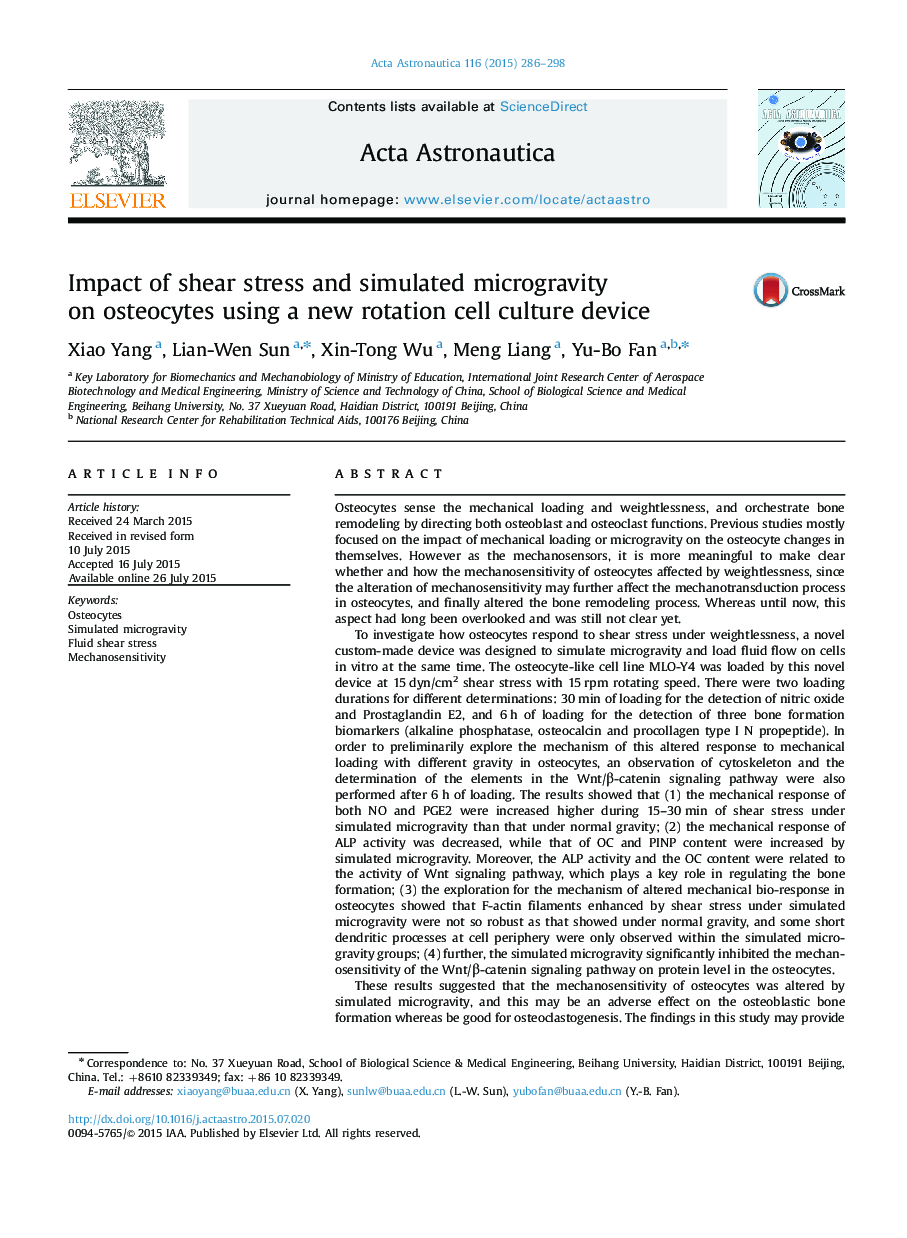| کد مقاله | کد نشریه | سال انتشار | مقاله انگلیسی | نسخه تمام متن |
|---|---|---|---|---|
| 1714302 | 1519938 | 2015 | 13 صفحه PDF | دانلود رایگان |
• A device was designed to simulate microgravity and load fluid shear simultaneously.
• Osteocytes bioresponse to fluid shear under simulated microgravity was researched.
• Microgravity affected molecules secretion and proteins responding to fluid shear.
• Microgravity affected response of the Wnt/β-catenin signaling pathway to fluid shear.
• We provided a clue for searching an efficient way against osteoporosis in space.
Osteocytes sense the mechanical loading and weightlessness, and orchestrate bone remodeling by directing both osteoblast and osteoclast functions. Previous studies mostly focused on the impact of mechanical loading or microgravity on the osteocyte changes in themselves. However as the mechanosensors, it is more meaningful to make clear whether and how the mechanosensitivity of osteocytes affected by weightlessness, since the alteration of mechanosensitivity may further affect the mechanotransduction process in osteocytes, and finally altered the bone remodeling process. Whereas until now, this aspect had long been overlooked and was still not clear yet.To investigate how osteocytes respond to shear stress under weightlessness, a novel custom-made device was designed to simulate microgravity and load fluid flow on cells in vitro at the same time. The osteocyte-like cell line MLO-Y4 was loaded by this novel device at 15 dyn/cm2 shear stress with 15 rpm rotating speed. There were two loading durations for different determinations: 30 min of loading for the detection of nitric oxide and Prostaglandin E2, and 6 h of loading for the detection of three bone formation biomarkers (alkaline phosphatase, osteocalcin and procollagen type I N propeptide). In order to preliminarily explore the mechanism of this altered response to mechanical loading with different gravity in osteocytes, an observation of cytoskeleton and the determination of the elements in the Wnt/β-catenin signaling pathway were also performed after 6 h of loading. The results showed that (1) the mechanical response of both NO and PGE2 were increased higher during 15–30 min of shear stress under simulated microgravity than that under normal gravity; (2) the mechanical response of ALP activity was decreased, while that of OC and PINP content were increased by simulated microgravity. Moreover, the ALP activity and the OC content were related to the activity of Wnt signaling pathway, which plays a key role in regulating the bone formation; (3) the exploration for the mechanism of altered mechanical bio-response in osteocytes showed that F-actin filaments enhanced by shear stress under simulated microgravity were not so robust as that showed under normal gravity, and some short dendritic processes at cell periphery were only observed within the simulated microgravity groups; (4) further, the simulated microgravity significantly inhibited the mechanosensitivity of the Wnt/β-catenin signaling pathway on protein level in the osteocytes.These results suggested that the mechanosensitivity of osteocytes was altered by simulated microgravity, and this may be an adverse effect on the osteoblastic bone formation whereas be good for osteoclastogenesis. The findings in this study may provide an important clue for searching an efficient approach to prevent osteocytes from changing the orchestration for bone remodeling under microgravity, and further this prevention may finally make the physical exercises capable against bone loss under microgravity.
Journal: Acta Astronautica - Volume 116, November–December 2015, Pages 286–298
